I would like to draw a graph showing the relationship between rotation speed and power of an ideal Sinus PMAC generator
- with a brake resistor R(load) to be defined
- controlled via a 4Q Controller acting as recifier
- based on datasheet figures (=> cannot measure, known figures see below)
- ignoring losses
In the end I want to know if I calculate the impact of the load resistor correctly. Here a schematic as an example. The load resistor replaces the main battery since I only use it for braking:
Datasheet only contains torque constant. (Calculating Back EMF from Torque Constant)
Assumtion: BEMF constant = Torque constant * SQRT(3) / 2
Here is, what I have up to now:
- Assuming 1 Rotation per sec => rad speed $$\omega = 1*2*\pi = 6,28$$
- \$U(sin) = \omega \frac{\sqrt{3}}{2} = 0,653 V\$
By substitution of U with I*R(L) of the following formulas:
$$U = \phi _{m}* \omega -I*R _{i}$$ $$U = I*R_{L} $$
I got:
$$I = \frac{\phi _{m} \omega}{R_{i} + R_{L}}$$
$$I = \frac{0.12*6.28}{0.065 + 0.065} = 5.8A$$
$$P = I * U = 5.8A * 0.653V = 3.8W$$
At a rotation speed of 3400 rpm I would get 12kw of mechanical braking power. Does this make sense?
I would prefer a calculation without magnetic field theory - if possible... Thank you :)
Datasheet:
- 12kw continuous, 30kw Peak
- Phase to Phase winding resistance is 0.065 Ohms with 20 turns per phase.
- Voltage: 0 to 72 VDC input to the control
- Torque constant of 0.12 Nm per Amp
- The Inductance Phase to Phase is 0.05 Milli-Henry
- Current: 165 Amps AC continuous (200 Amps DC into the motor control)
- Peak current: 450 Amps AC for 1 minute (620 Amps DC into the motor control)
- Peak Stall Torque: 75 ft lb.
- 4 pole motor (8 magnets)
- Maximum recommended rotor speed: 6500 RPM
- Armature Inertia: 45 Kg Cm Squared
